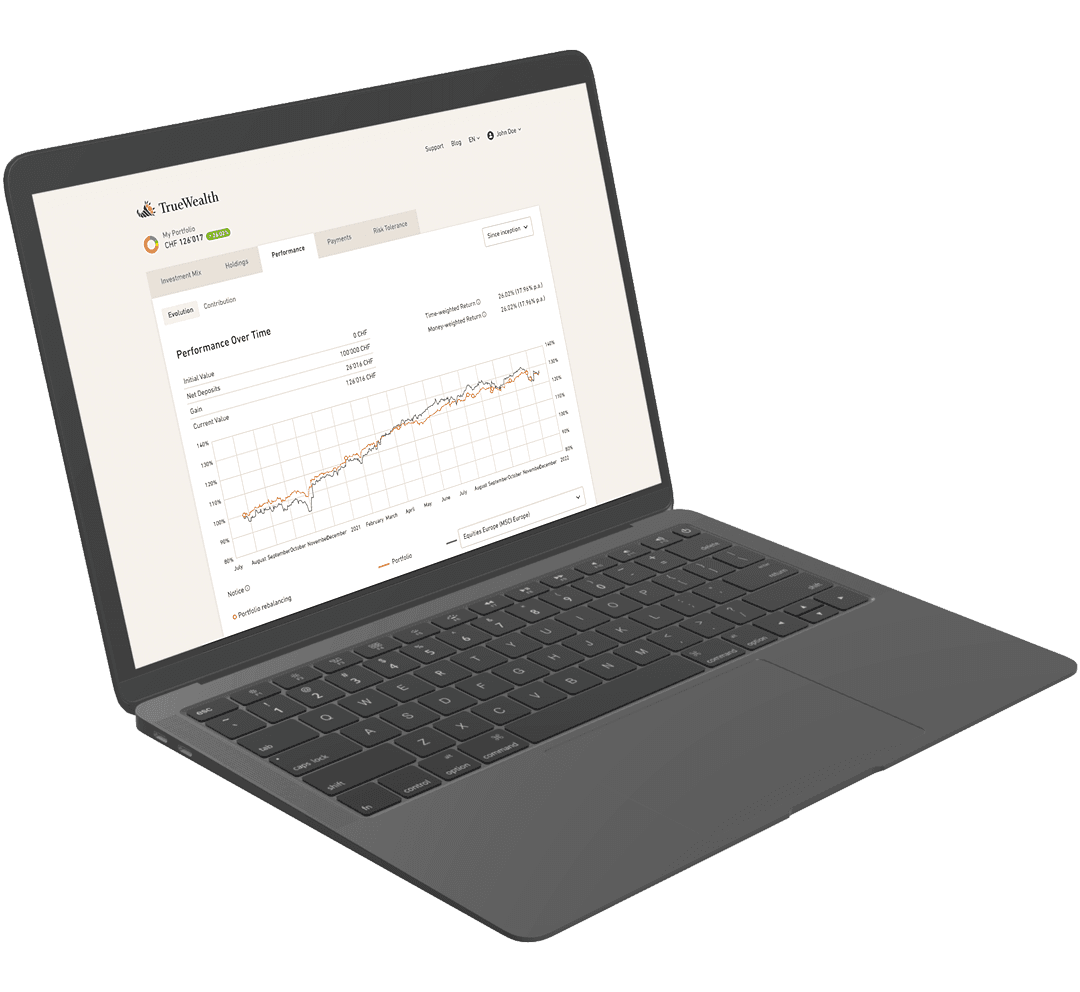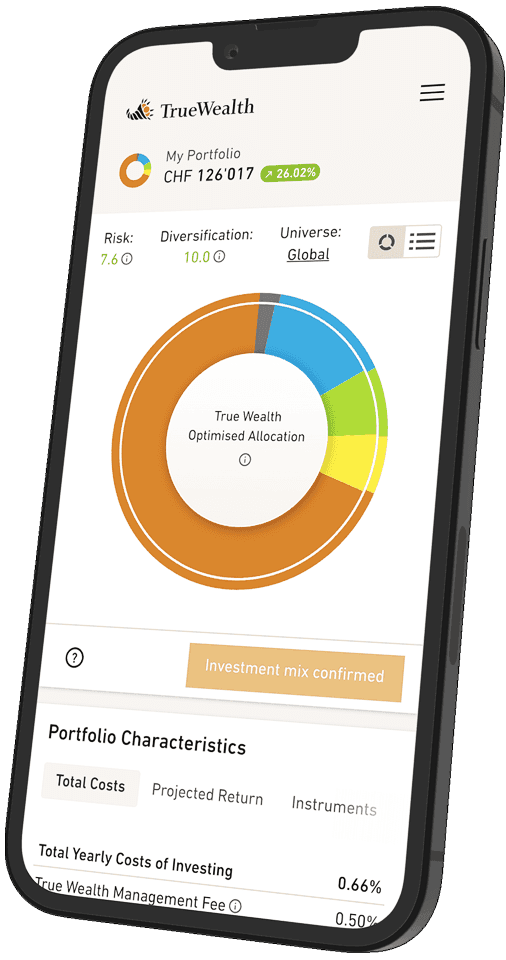
Inflation: Protecting Wealth With Real Assets
Commodities, stocks, real estate: Real assets tend to preserve their value better. Discover here how to set up your portfolio to protect against inflation.
Inflation means that money becomes worth less. The balance of a bank statement may stay the same, or it may even increase: But when your money buys less, your assets shrink as the loss of purchasing power gnaws away at their value.
Not all asset classes are equally affected by this loss of purchasing power. So the question arises: Which financial investments hold their value best during inflation? Is it possible, with the right investments, to end up with not less, but even more purchasing power?
Before we take a deeper look at this, here are two important comments:
Real assets are the best way to protect wealth. This is the expectation raised by the title of this article. And it is also true that tangible assets preserve wealth best. But...
The protection may only be relative. It may well be that in periods of inflation all financial assets lose purchasing power – but real assets simply lose the least.
Before we take a closer look at real assets and explore the possibilities of how best to use them to set up your portfolio for inflation, let's take a quick look at the worst performing asset classes in times of inflation.
Avoid Cash and Bonds
As the saying goes, cash is safe. And this is usually true, because it's not subject to fluctuations in value. At least if you don't think outside the box and limit yourself to the currency of your home country. But when it comes to inflation, one thing above all is certain: Inflation gnaws away at purchasing power.
If we define cash a little more widely than coins and notes, we can also put it in a bank account. Depending on how much money you keep in the account and who you bank with, a negative interest rate will then also erode your assets. First the balance gets smaller, then inflation eats away at the purchasing power. Which is doubly bad.
Negative interest rates can be avoided with bonds that have long enough maturities. Investors committed for long enough have been able to achieve yields above zero despite the extremely loose monetary policy. In euros and in francs, this usually required maturities of ten or more years.
However, as the maturity of the bond increases, so does its interest rate risk. And when interest rates rise, bonds lose value, especially long-dated ones. And even if interest rates remain low, inflation can wipe out the modest returns on long-term bonds.
Read more about bonds in this article – Bonds in Inflation: Safe is Suddenly No Longer Safe.
Real Assets Perform Stronger in Inflationary Periods
Investments in real assets perform significantly better than cash and bonds during periods of inflation. But beware: The definition of real assets is not universally valid. When talking about real assets, almost everyone has something different in mind.
A very narrow definition of real assets means only real tangible assets, i.e. ones that you can touch. For example, real estate (such as a home or a shopping centre) or infrastructure (a power line or an airport) as well as all of the physical raw materials from which something is made (whether these be permanent tangible assets or consumer goods). Such a narrow definition distinguishes real assets from financial assets. As a result of this, shares belong to financial assets just as much as cash or bonds do.
At True Wealth, we follow a broader definition than this. We also count shares as real assets, just like any other form of security that makes real assets tradable on the stock exchange. An example of this is real estate shares or ETFs on commodities. Our definition therefore includes not only values that can be touched in real terms, but also all investments in things that are deemed useful in the real world.
This broader universe of real assets specifically includes commodities, equities, real estate and collectibles. Let's take a look at each of these asset classes in more detail – especially in terms of how they perform in inflationary periods.
Commodities
Investments in commodities are the obvious winners in times of inflation. Historically, this has been shown time and again. This was particularly evident in the 1970s – the previous phase of high inflation in the Western industrial nations.
Annual inflation rates in Switzerland and the US in the 1970s, a period of high inflation marked by the 1973 oil shock. Source: Bloomberg, CPI.
At that time, the prices of various commodities rose sharply across the board – and of course the asset class as a whole.
Commodities generated particularly high returns in the last period of sustained inflation. Source: Bloomberg Commodity Index Total Return and Gold Spot US Dollar Per Troy Ounce.
Commodities include agricultural products such as wheat or corn, but also pork or orange juice and many more.
Commodities also include all tradable forms of energy, whether in unprocessed form such as crude oil, but also in refined products such as heating oil, petrol, natural gas, liquid gas or electricity.
Metals form the third large group of commodities. It's no surprise that copper is considered a raw material seeing as it plays such an important role as a building material. However, the role of other metals as an industrial raw material is not quite so clear. Gold is only used to a small extent in production, such as with the production of semiconductors. In bullions, on the other hand, gold serves primarily as a store of value – yet we still count it as a commodity, like all other metals.
In our client portfolios, we use an ETF that is diversified across the different commodity sectors. If you wish, you can even add the precious metals of gold and silver individually with specific ETFs.
For your portfolio: Commodities provide preservation of value in the face of inflation. However, they also come with fluctuations. Therefore, in times of inflation, it can be worthwhile for you to increase your share of commodities (or to invest in commodities for the first time).
Shares
Shares are interests in companies, that is, pieces of ownership in companies. What is good for companies is good for shares. Inflation as such is neither good nor bad for companies.
In inflationary periods, prices for raw materials and wages rise, which is bad for companies' profits. But if the company can increase its own prices at the same time, then that is good for profits. So it may well be the case that a company can do just as well with inflation as without it.
In principle, one should therefore assume that in theory, stocks are neutral in inflation: They do not lose value because of inflation, but they also do not gain because of it.
Nevertheless, many companies do report falling margins in times of inflation. And historically, equities have lost value in periods of strong inflation. For example, the seventies in the US – a period of persistent strong inflation – were so bad for equities that by the end of the decade they were even declared as dead. In August 1979, the US magazine Businessweek ran the headline «The Death of Equities. How inflation is destroying the stock market».
The crowding-out effect provides an explanation for this: To fight inflation, the only thing left for the central bank is to raise interest rates and thus to cool down the spending propensity of the state and of the economy. Once interest rates have risen to a high level, inflation is under control, and no further interest rate rises are expected, bonds become attractive again. Equities, on the other hand, suffer from the rise in interest rates because, in somewhat technical terms, the present value of their future dividends has fallen. And indeed, in the 1970s, long-term interest rates in the US also rose very sharply, peaking at 15% in 1981.
Between 1970 and 1979 the American stock index S&P 500 did rise from 92.5 to 148 points. However, the purchasing power in the US fell at the same time. Furthermore – not entirely unimportant for investors in Switzerland – the value of the dollar also fell significantly against the Swiss franc. At the end of the decade, an investment of 100 francs in the S&P 500 was only worth 58 francs, a full 42 percent less.
The Swiss market performed better in the inflationary decade of the seventies. 100 francs in Swiss equities was still worth 100 francs at the end of the decade.
Nominal (i.e. not inflation-adjusted) return on Swiss and American equities during the last period of sustained inflation.
Nominally – by number. Because in real terms, purchasing power fell during this inflationary period. In light of this, the fact that Swiss shares could hold their value nominally is only an advantage in relative terms. In Swiss francs, they were no better than cash. They lost ground in terms of real purchasing power – albeit less so than American shares.
Real (i.e. inflation-adjusted) return on Swiss and American equities during the last period of sustained inflation.
In the first half of the inflationary seventies, American shares still put up a good fight and until 1973, the S&P 500 was even able to maintain its purchasing power in real terms. It did later lose value though. Compared to the asset class of bonds, equities performed better in almost all years of the decade – and despite the loss in value were slightly ahead in the comparison of the two asset classes.
Real return on American stocks and bonds in the last period of sustained inflation.
This confirms what we assume from theory: Equities have the potential to preserve value in inflation. Bonds, on the other hand, are inevitably doomed to incur losses in inflationary periods (Read more about bonds here – Bonds in Inflation: Safe is Suddenly No Longer Safe).
But beware: Exceptions prove the rule. The Swiss markets produced a different result for Swiss investors. Here, too, bonds lost value at the end of the decade. Equities, however – quite contrary to their theoretical advantage – did even more so.
Real return on Swiss equities and bonds in the last period of sustained inflation.
Bonds can only lose in inflationary times. Shares have the potential to preserve the value of your assets, although whether they unfold this potential is not guaranteed. And besides, the potential has a price: Shares fluctuate more in value than bonds.
For your portfolio: Shares are a good substitute if you want to reduce the proportion of bonds and if you are able to cope with fluctuations in value.
Real Estate
Whether you choose the narrow or the broader definition, real estate is definitely a real asset. If you use your real estate for personal use and daily living, it will retain its utility value 1:1. A three-room flat with a view remains a three-room flat with a view.
However, the comparison could be different in terms of purchasing power. Rents often do not rise quite as fast as other items under sustained inflation. It is therefore possible that an equivalent flat could be rented for less after years of inflation. For landlords, this may also mean that yields do not rise in line with inflation. It is therefore not possible to say conclusively how real estate performs in comparison with other asset classes.
Most owners – whether for their own use or for letting the property – raise only part of the purchase price from their own capital. They finance the rest, often the greater part of the property value, with loans – such as a mortgage, thus giving leverage to real estate investments. And this leverage is an advantage in times of inflation. Although the debt remains nominally the same, it loses value in real terms, i.e. compared to its purchasing power. If the value of the property keeps pace with the purchasing power, the gains on property equity are considerable.
But beware: Value preservation of real estate is by no means certain. For existing mortgages, the interest rate is often fixed for years to come. Today, anyone looking to take out a new mortgage will have to pay twice as much for a ten-year mortgage in June 2022 as they did at the beginning of the year – two and a half percent instead of one percent. If inflation continues for years, then interest rates will likely have to rise even further. So there may well not be enough buyers left who are still able to finance real estate at current prices.
For your portfolio: Real estate with leverage offers great opportunities, but also great risks. Shares in real estate are a good substitute if you want to reduce the proportion of bonds.
Other Real Assets
With True Wealth, you can invest with your portfolio via ETFs in the following asset classes: Commodities, equities and real estate. That is why we have discussed them thoroughly in this article. Outside the world of ETFs, however, other investments also offer a prospect of value preservation in periods of inflation.
Although cryptocurrencies are anything but tangible assets, they are already considered real assets by their followers. Even if – viewed in the light of day – they consume vast amounts of real resources instead of creating them. What essentially distinguishes them from state money is their artificial scarcity of supply. That is why they are said to rule out inflation by printing money. In individual cryptocurrencies, the amount of money is limited – but the amount of currencies as a whole is not: New cryptocurrencies are created almost daily. Their market value can collapse at any time. (Even by almost 100 percent, as illustrated by the crash of the stablecoin issuer LUNA in May 2022).
Particularly tangible are classic collectibles – such as old wines, old masters or vintage cars. In recent years, contemporary limited edition products such as sneakers have also gained popularity among collectors. And finally, collectibles that cannot be touched: Digital originals in the form of non-fungible tokens (NFT). Individual objects can achieve spectacular increases in value. However, this does not mean that collectibles as such can generally be expected to perform superiorly during inflationary periods.
The Risk of Taking too Little Risk
Real assets are useful for preserving wealth. However, their prices are subject to fluctuations. Their volatility is greater than for bonds, which is why portfolios are not built exclusively from real assets.
Investors generally use a large proportion of bonds. In phases of inflation, however, bonds carry special risks. They are so important that we devote a separate article to them – Bonds in Inflation: Safe is Suddenly No Longer Safe.
Volatility is often equated with risk – the risk that the price will fall. But in fact, volatility is also a prerequisite for the price to rise – so it is therefore an opportunity as well. How can you take advantage of this opportunity in your portfolio at True Wealth?
Reassess Your Risk Tolerance
Our algorithm determines an individual investment proposal to match your risk tolerance. The lower your risk tolerance, the more bonds the model suggests – in line with the classical doctrine.
To help us assess your risk tolerance, we will ask you some questions. These questions inevitably contain the eternal conflict of objectives in investing money. It goes without saying that every investor wants as little fluctuation in value as possible in the short term and ideally an increase in value in the long term. Unfortunately, both goals cannot be achieved at the same time. Therefore, you have to weigh them up. The questions help you achieve this – but only if you give completely honest answers.
To do this, click on: «Reassess your risk tolerance» in your portfolio and then on «Reassess entire risk profile».
The questionnaire will ask you about your risk tolerance and risk appetite. If you have already been invested for a few years with profits, your risk tolerance will have usually increased. In view of the current inflation, many people's risk appetite is also increasing – perhaps this is the case for you as well?
Both factors could lead to a higher rating than before – and thus to a portfolio that may be better positioned for inflation.
Adjusting by Hand
Shares, real estate shares, cash, bonds and commodities: All asset classes are available in every portfolio. Their weighting corresponds to the investment proposal. The portfolios in the sustainable strategies weight commodities with zero percent. You can also adjust the investment mix yourself at any time using the sliders in the portfolio.
You could do this.
But you don't have to: Our algorithm ensures good diversification because diversification makes for superior portfolios. (Read more here: Put all your eggs in one basket: Diversification). You can tell that your portfolio corresponds to the model portfolio by the label «True Wealth optimised investment strategy».
Do not take the importance of this diversification lightly. The best way is to regularly reassess your risk tolerance – as described in the previous section.
Perhaps Better to Spend?
One thing is certain: In times of low interest rates and rising inflation, investors face a challenge. History shows that in phases of inflation, wealth is consumed. This will most certainly occur if you bet on avenues that are otherwise considered safe. Even then, if you take more risk today, that only gives you the chance to preserve your capital. It can’t guarantee it.
We cannot eliminate this dilemma completely. Instead, we can only cushion it with optimal diversification and low investment costs. Whatever is measured in money is at stake in periods of inflation.
If inflation rates in Switzerland climbed into double digits, it would be difficult to generate a positive return in real terms even with a pure equity portfolio. Then one could only advise consumption. It seems, at least in Switzerland and the US, that it will not come to that. The Fed and the SNB have taken the reins again and have started to raise interest rates.
«And what if, for once, you didn't invest in assets but in yourself?»
But what if you invested very differently in times of inflation? For once, not in assets, but in yourself? This could be through further education, a trip to learn about another culture, or even a sabbatical. The experience and knowledge you carry in your head and heart cannot be eaten away by inflation.
This article is part of a series on inflation:
- You can read here how inflation impacts bonds and what you can do about it – Bonds in Inflation: Safe is Suddenly No Longer Safe.
- In our article – Inflation: The Tax Nobody Wants to Pay we explore where inflation comes from, who it benefits and what it means for you.
About the author

Founder and CEO of True Wealth. After graduating from the Swiss Federal Institute of Technology (ETH) as a physicist, Felix first spent several years in Swiss industry and then four years with a major reinsurance company in portfolio management and risk modeling.

Ready to invest?
Open accountNot sure how to start? Open a test account and upgrade to a full account later.
Open test account